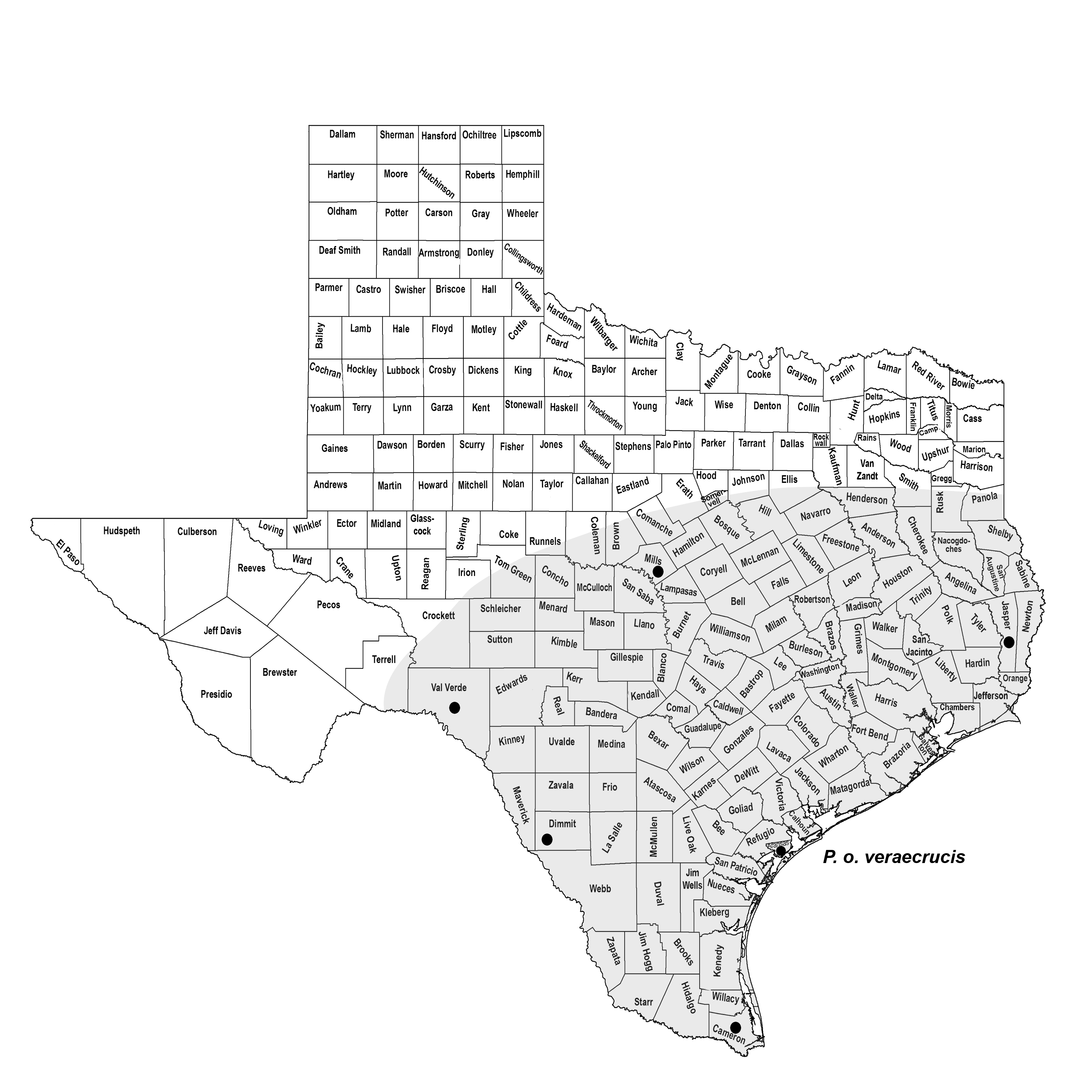JAGUAR
Panthera onca (Linnaeus 1758)
Order Carnivora : Family Felidae
DESCRIPTION. Largest of the spotted American cats; form robust; tail relatively short and tapering; ears small, short, and rounded, without tufts; pelage short and rather bristly; upperparts spotted at all ages; ground color buffy to tan, spots blackish, often with light-colored centers; underparts and inner surfaces of legs white, heavily spotted with black; tail with irregular black markings. Dental formula: I 3/3, C 1/1, Pm 3/2, M 1/1 × 2 = 30. External measurements of an adult male: total length, 1.9 m; tail, 533 mm; of a female, 1.6 m-432 mm; height at shoulder of a large male, 712 mm. Weight, up to 90 kg; one male from Texas weighed 63.6 kg, another, 42 kg.

DISTRIBUTION. The jaguar inhabits the dense chaparral and timbered sections of the New World tropics and seldom ventures into the high, cooler inland areas. Apparently, it was once fairly common over southern Texas and most of the eastern part of the state to Louisiana and north to the Red River. It is now extirpated from the state.

SUBSPECIES. Panthera o. veraecrucis is the historical subspecies recognized in Texas.
HABITS. Jaguars are the third largest cat in the world, ranking behind the tiger and African lion. In spite of their large size and powerful build, however, jaguars are shy and seldom seen. They are thought to require a large territory for survival, and nowhere are they abundant.
Their food habits are not well known. In Mexico, they prey on peccaries, deer, and large ground-dwelling birds. Jaguars are reputed to be so destructive of cattle and horses that the larger Mexican ranches retain cazadores, or hunters, to kill them or at least to drive them away. Jaguars are also fond of sea turtle eggs, and they roam the beaches on spring nights to dig up and eat the eggs that are buried in the sand.
The den is a rocky cave or the security of a dense, thorny thicket. The mating season is in December and January, and the two to four young are born in April or May after a gestation period varying of 93–110 days. The kittens are covered with woolly fur, are heavily spotted at birth, and have their eyes closed. When about 6 weeks old, they are as large as house cats and begin to follow their parents. Females rear the young. The family unit of the mother and her offspring is maintained until the kittens are nearly 1 year old, at which time they begin to fend for themselves.
POPULATION STATUS. Extinct. The jaguar is extinct in Texas today. There are many records and sightings that date from the late 1800s and early 1900s, and this large cat actually was regarded as common in some areas. The most recent documented record from the state was in 1948 when the last jaguar was shot 4.8 km (3 mi.) southeast of Kingsville, Texas.
CONSERVATION STATUS. The IUCN lists the jaguar as near threatened and decreasing in numbers. The jaguar is listed as endangered by TPWD and USFWS. This species is regarded as endangered throughout its relatively broad range in Central and South America. Recently, a few jaguar sightings have been recorded from Arizona and in central Tamaulipas south of the Texas border.
From The Mammals of Texas, Seventh Edition by David J. Schmidly and Robert D. Bradley, copyright © 1994, 2004, 2016. Courtesy of the University of Texas Press.
Natural Science Research Laboratory
-
Address
Museum of Texas Tech University, 3301 4th street, Lubbock, TX 79409 -
Phone
806.742.2486 -
Email
nsrl.museum@ttu.edu

